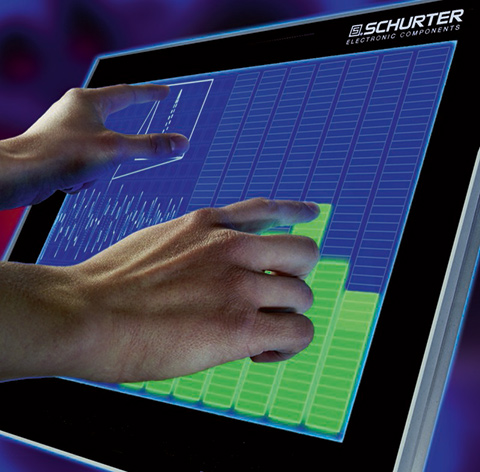
Posted to News on 3rd May 2023, 16:24
Multitouch applications with resistive touch technology

The PCAP technology is currently the most common input medium for multitouch applications. However, there are certain applications that still require resistive touch technology. What is the reason for choosing the resistive multi-touch technology? In which applications will it be used? We asked the experts at Schurter.
Reasons for using resistive touch technology are the absolute resistance to extreme EMC interference, the need for an actuating force and the safe function with conductive media such as water, blood or salt solution on the full-surface touch panel. In addition, compared to a PCAP touch screen, a resistive touch screen can be completely shielded at the front with a metal mesh grille.
The resistive technology has been further developed to enable the multitouch functionality. The two ITO layers, film and glass, of a resistive multi-touch screen are structured in rows and columns (x and y direction) and individually put in contact with the connecting tail. The layers are kept apart by printed micro-dots. When the resistive multi-touchscreen is actuated, both layers make contact. The position is still evaluated with analogue resolution in the individual zones. The touch screen controller for the evaluation can be placed either as chip-on-flex, as a separate board or on customized electronic boards. Possible interfaces are USB and I2C.
Resistive multi-touchscreens require a low actuation force and can therefore be operated with a variety of objects such as fingers, pens and thick gloves.
Application areas
This technology was developed for applications where PCAP technology reaches its physical limits and multitouch functionality is required. These are mainly applications where no EMC radiation is allowed to escape to the outside. A PCAP touchscreen cannot be shielded at the front because this would block the capacitive field at the same time. With resistive touch, the shielding can be laminated onto the upper ITO film in a highly transparent manner.
The resistive touch screen requires an actuating force for evaluation, which is not impaired by the conductive and flexible shielding layer on the surface. This shielding layer makes contact with the metallised housing, whereby the application is completely EMC-shielded. Resistive multi-touch technology is used in medical applications such as MRI or CT, where interference fields can cause negative interaction.
For communication applications in high-security areas, tap-proof input systems are realised with this resistive multitouch technology.
Thus, resistive multi-touch panels offer reliable operation in different environments without interfering signals. Even if the touch panel surface is covered with conductive liquids, this technology ensures safe functionality and correct gesture and multi-touch operation.
Every Schurter input system is a customised solution. Designing input systems for the most demanding applications requires a high level of know-how and experience. Schurter’s engineers develop and design the optimal HMI solution in close cooperation with customers. The right choice of the most suitable multitouch technology for each application is made on the basis of the application requirements.
Want the latest machine building news straight to your inbox? Become a MachineBuilding member for free today >>
Unit 3, Mildshires Business Park
Smeaton Close
HP19 8HL
UNITED KINGDOM
+44 (0) 1296 319 000

















